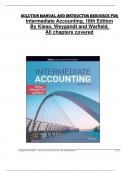Exam (elaborations)
Solution Manual and Instructor Resource for Intermediate Accounting, 18th Edition By Kieso, Weygandt and Warfield. All chapters covered, ISBN:9781119790976
Solution Manual and Instructor Resource for Intermediate Accounting, 18th Edition By Kieso, Weygandt and Warfield. All chapters covered, ISBN:9781119790976 Solution Manual and Instructor Resource for Intermediate Accounting, 18th Edition By Kieso, Weygandt and Warfield. All chapters covered, ISBN:...
[Show more]



